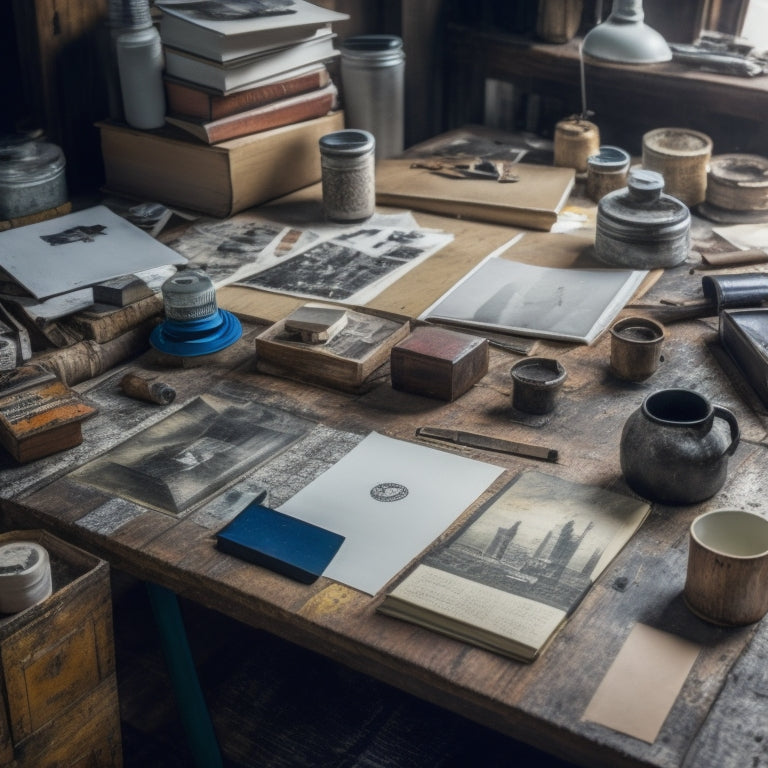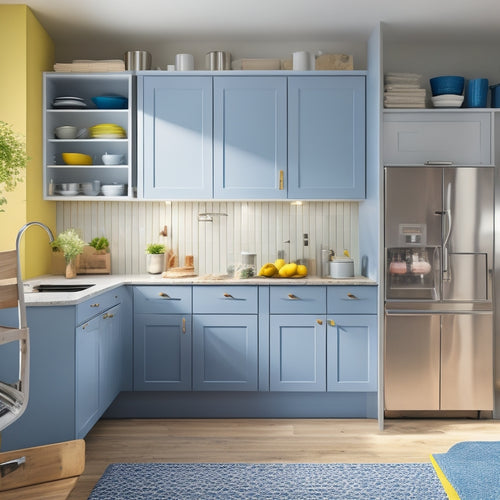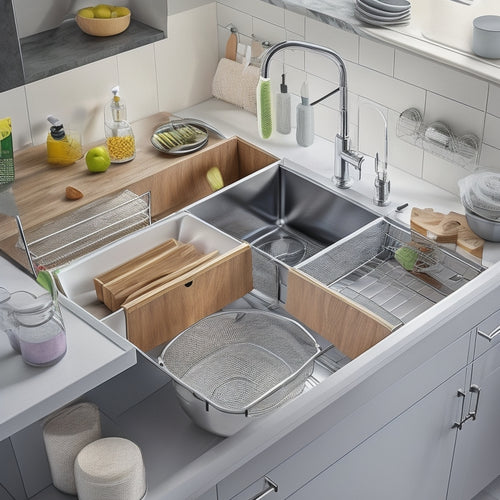
Unlocking the Art of Printmaking: Essential Guide
Share
You're about to reveal the art of printmaking, a journey where art meets technique and self-expression knows no bounds. To get started, you'll need to select the right ink, paper, and tools for the job. Set up a well-ventilated home studio with a clean and stable work surface, and invest in storage solutions for your supplies. From monotype printing to intricate designs, mastering printmaking processes requires experimentation and practice. With the right techniques and tools, you'll be able to push the boundaries of creative expression. Now, discover the secrets to revealing your full printmaking potential.
Key Takeaways
• Mastering printmaking techniques requires careful selection of ink viscosity, color, and paper type to achieve desired effects.
• A well-organized and well-ventilated home studio is essential for producing high-quality prints and ensuring safety.
• Printmaking is an excellent medium for kids and families to foster creativity, self-expression, and bonding through collaborative art projects.
• Essential tools like brayers, baren, palette knives, acetate, and plexiglass are necessary for achieving professional-grade prints.
• Experimenting with different paper types, textures, and techniques like monotype printing can help unlock new creative possibilities in printmaking.
Printmaking Techniques and Supplies
When venturing into the world of printmaking, you'll find that mastering various techniques requires a solid understanding of the specific supplies needed for each process. Ink mixing, for instance, is an important step in many printmaking methods. You'll need to select the right ink viscosity and color to achieve the desired effect.
Paper selection is another essential aspect, as different papers react differently to ink and pressure. You'll need to choose papers that are suitable for the specific technique you're using, taking into account factors like texture, weight, and absorbency.
Setting Up Your Home Studio
Now that you've got a solid grasp of printmaking techniques and supplies, it's time to create a dedicated space where you can experiment and refine your craft, free from clutter and distractions. A well-organized studio is essential for a creative workspace. Consider the following key elements to set up your at-home printmaking studio:
| Studio Organization | Tips and Guides |
|---|---|
| Designate a specific area for printing | Choose a well-ventilated area with good lighting |
| Invest in storage solutions for tools and supplies | Label and categorize your storage for easy access |
| Create a clean and stable work surface | Cover your work surface with a protective layer, such as a vinyl tablecloth |
| Establish a routine for cleaning and maintaining your space | Schedule regular cleaning sessions to prevent ink buildup and mess |
Printmaking for Kids and Families
Introduce your children to the world of printmaking, a fun and educational activity that fosters creativity, experimentation, and self-expression. This engaging art form allows kids to explore their imagination and develop essential skills like problem-solving and critical thinking.
As a parent, you can encourage your child's artistic growth by participating in parent-child workshops or guiding them through creative projects at home.
Here are three ways to get started:
-
Simple relief printing: Carve a design into a soft material like styrofoam or linoleum, and let your child experiment with inking and printing.
-
Monotype making: Use a smooth surface like plexiglass or mylar to create unique, one-of-a-kind prints.
-
Collaborative art: Work together on a printmaking project, taking turns adding layers and textures to create a stunning piece of art.
Remember to prioritize safety and supervise your child during the process. With patience and guidance, printmaking can become a wonderful bonding experience for the whole family.
Essential Tools of the Trade
As you set up your home printmaking studio, invest in a few essential tools that will elevate your creative process and guarantee consistent results, starting with the humble brayer. This versatile printmaking equipment is used to apply ink to your design, ensuring even distribution and texture.
Next, stock up on various types of paper suitable for different printmaking processes. A baren tool is also essential for adding pressure to paper, while palette knives are important for mixing ink.
Additionally, consider acetate and plexiglass for containing mess and creating designs. These printmaking essentials will form the foundation of your creative journey, allowing you to experiment with different techniques and achieve professional-grade results.
Mastering Printmaking Processes
With your printmaking studio setup and essential tools in place, you're ready to explore the various techniques that will bring your creative vision to life, starting with the unique characteristics of monotype printing.
This process allows for advanced techniques and creative exploration, enabling you to achieve unique, one-of-a-kind prints.
To take your printmaking skills to the next level, focus on:
- Mastering the art of layering ink and manipulating paper to achieve intricate designs.
- Experimenting with different paper types and textures to add depth and interest to your prints.
- Practicing professional tips, such as using registration pins to guarantee accurate alignment and registration.
Frequently Asked Questions
How Do I Price and Sell My Printmaking Art Online and In-Person?
You'll successfully price and sell your printmaking art by researching online marketplaces, calculating production costs, and targeting art festivals where your unique style resonates, ensuring a safe and profitable online and in-person presence.
Can I Mix and Match Different Printmaking Techniques for Unique Results?
You can create visually stunning prints by mixing and matching techniques, embracing visual experimentation and layered complexity. Try combining relief printing with cyanotype or screen printing with monotype to achieve unique, intricate designs that showcase your artistic vision.
How Do I Fix Common Mistakes and Imperfections in My Prints?
As you navigate the printmaking landscape, imperfections can creep in like unwanted weeds. To tame these flaws, carefully inspect your prints for registration errors and ink inconsistencies, then employ targeted troubleshooting techniques to salvage your artwork.
Are There Any Environmental Concerns With Printmaking Materials and Processes?
You're right to prioritize environmental concerns in printmaking. Opt for sustainable inks, eco-friendly studios, and responsible waste management to minimize your ecological footprint.
Can I Use Printmaking to Create Functional Items Like Fabric and Ceramics?
You can awaken a tidal wave of creativity by using printmaking to craft stunning fabric patterns and ceramic designs, and yes, it's absolutely possible, with the right techniques and materials, to turn your prints into functional masterpieces!
Related Posts
-

Smart Storage Solutions for Small Kitchen Spaces
You're struggling to find space in your small kitchen, but don't worry, smart storage solutions can help. Start by ut...
-

LYNK PROFESSIONAL: Transform Your Under-Sink Storage
Transform your under-sink storage with LYNK PROFESSIONAL, a cleverly designed system that tackles common challenges. ...

